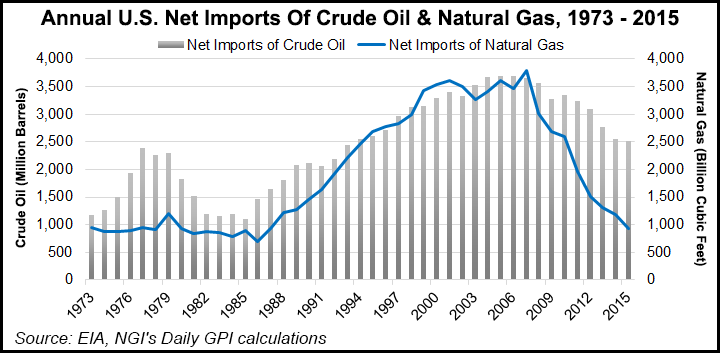Markets | LNG | NGI All News Access | NGI The Weekly Gas Market Report
North America Largest LNG Exporter by 2040, ‘Significant’ Oil Trader in 2025, Says ExxonMobil
North America will become the largest natural gas exporter by 2040 from growth in unconventional production, with oil exports predicted by 2025, ExxonMobil Corp. is forecasting in its “Outlook for Energy: A View to 2040.”

Global population growth of nearly two billion, a doubling of worldwide economic output and rapid expansion of the middle class in emerging economies all combine to contribute to energy demand growth of about 25% from 2015 to 2040, according to the annual forecast.
“As economies expand around the world, energy demand will increase as more people seek higher standards of living,” said ExxonMobil’s William Colton, vice president of corporate strategic planning. “Humanity’s dual challenge is to meet growing energy demand while managing the risk of climate change. Our ‘Outlook for Energy’ can help people understand factors influencing future energy supply and demand and inform industries and governments as they consider future energy policy.”
The annual outlook is ExxonMobil’s long-range forecast developed by its economists, engineers and scientists through data-driven analysis, which examines energy supply and demand trends for close to 100 countries, 15 demand sectors and 20 different energy types. ExxonMobil uses the forecast as a foundation for its business strategies and to help guide multi-billion dollar investment decisions. BP plc and several other Big Oil majors also issue annual forecasts to guide their business decisions.
The key findings in ExxonMobil’s 2017 forecast are:
For natural gas bulls, the coming decades look strong, with North America becoming the largest liquefied natural gas (LNG) exporter to 2040 from growth in tight gas and shale formations.
Global LNG trade is expected to increase more than 2.5 times from 2015 to 2040, with Europe and Asia Pacific accounting for about 90% of imports. Asia Pacific is seen accounting for more than two-thirds of worldwide LNG growth, with some of it partly sourced from within the region.
“LNG export supplies diversify as demand grows,” according to the forecast. “Significant new exports” are expected from the United States, Canada, Australia and East Africa. The gas source should “remain highly competitive” because of abundant resources and “many aspiring exporters.” Low-cost supply sources “will be advantaged in the marketplace.”
Global gas resources are abundant, according to North America’s No. 1 gas producer.
“Less than 15% of global gas resources have been produced,” according to the forecast, with remaining resources able to provide “more than 200 years of supply at current demand.”
Gas resource estimates should continue to rise, “as technology unlocks resources previously considered too difficult or costly to produce.” More than 40% of the world’s remaining gas resource is expected to come from unconventional sources, including tight and shale gas.
Efficiency gains across economies worldwide are seen playing a significant role in limiting the growth in energy needs. Energy demand in member nations of the Organisation for Economic Co-operation and Development (OECD) is likely to be flat to 2040, while demand in non-OECD nations is expected to increase 40% as prosperity expands and access to modern energy increases.
“Growth in global energy demand will be led by greater electrification of the global economy,” said ExxonMobil’s forecasters. “Fifty-five percent of the energy demand growth over the next quarter century will be tied to power generation needed to support the increasingly digital and plugged-in lives of society.”
Average electricity use per household is forecast to rise about 30% between 2015 and 2040. The share of the world’s electricity generated by coal is expected to fall to about 30% from 40% in 2015 as the use of lower-emission energy sources including natural gas, nuclear and renewables increases.
With the global middle class more than doubling to about five billion, the number of cars, sport-utility vehicles and pickups are expected to increase about 80% to 1.8 billion vehicles by 2040. During the same period, average new car fuel economy will improve from about 30 mpg to nearly 50 mpg, reflecting strides in efficiency of conventional vehicles and a shift in the fleet mix favoring hybrid vehicles, the report indicated.
© 2024 Natural Gas Intelligence. All rights reserved.
ISSN © 1532-1231 | ISSN © 2577-9877 | ISSN © 1532-1266 |
